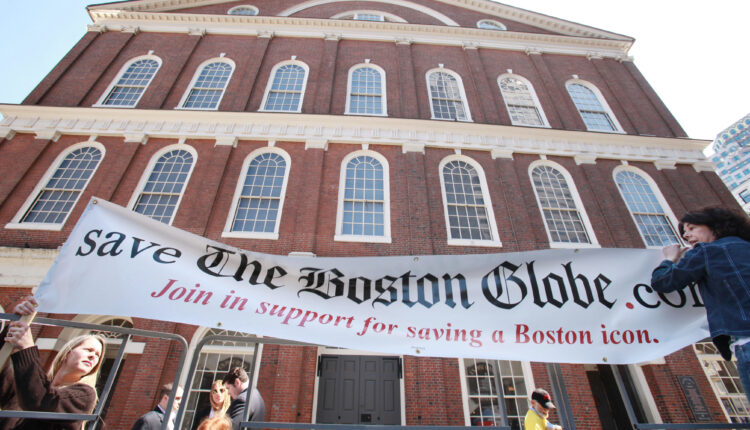Elites Started Killing Newspapers Long Before the Internet
“They all had purple hair – or pink hair,” he said. “One or the other. Sometimes nose rings too, but always the pink or purple hair.”

Newspapers ain’t what they used to be, but it wasn’t only the Internet, wokeness, and the Red Chinese virus that ruined them beyond repair.
The Beautiful People started destroying newspapers long before any of the above catastrophes. And finally, one of the pampered pukes involved in the decimation of the industry has admitted it.
David Brooks is a typical product of the “elite” media – foreign born, fabulously wealthy, a guy who not only wasn’t in the military and doesn’t go to church, but someone who’s never even met anybody who did either.
In addition to the Times, David Brooks is a talking head on National Panhandler Radio. Do I have to draw you a diagram?
Yet last week, Brooks let the cat out of the bag about his ilk:
“Over the last decades, we’ve taken over whole professions and locked everybody else out. When I began my journalism career in Chicago in the 1980s, there were will some old crusty working-class guys around the newsroom. Now we’re not only a college-dominated profession; we’re an elite-college-dominated profession.”
That’s the bad news. The good news is, all these legacies in protected classes will soon have to flee back to the Hamptons and live off the trust funds Pater and Mater set up for them.
The Washington Post is on track to lose $100 million this year. The Globe is drowning in red ink. The Times’ web traffic is down 20 percent year to year.
What do I call that? A good start!
Brooks began his career as a conservative, believe it or not. But he seen his opportunities and he took ‘em. In 2008 he swooned in print over the perfect crease in Barack Obama’s trousers, and he was on his way.
See, only the comrades can make the big bucks in media. It’s even better if the fellow traveler can claim to have “evolved” from being an American.
Moving left is a common career trajectory among upwardly mobile connivers in the commentator class – Bill Kristol, “Mourning” Joe Scarborough, Ana Navaro, Jennifer Rubin, and all the grifters in what Donald Trump Jr. calls “the Pedo Project.”
Once you flip, you get to ride around in limousines and live in gated communities. But some people must still be “reporters” — actually hit the streets and talk to people who work for a living, cover fires, develop sources, etc.
As Brooks admits, the elite newsrooms have long since banned the people who used to do that sort of grunt work – blue collars, working-class kids, graduates of state schools and people who’ve ridden a bus or two.
Did you ever see the old movie “The Front Page?” It’s been remade several times, and one of the lead characters is the managing editor of the Chicago newspaper. His name is Walter Burns.
Over the years, the role of Walter Burns has been played in Hollywood by, among others, Cary Grant, Walter Matthau, and Adolphe Menjou. Big stars, in other words.
The real-life Walter Burns was named Walter Howey. Among many other things, Howey used to be the editor of this newspaper, when it was owned by Hearst.
When I went on the Hearst payroll, I used to work Saturday nights for a city editor named Eddie Corsetti, “the Inspector.” Just after World War II, Corsetti had been the overnight police reporter for the Boston American.
One of Corsetti’s tasks after midnight was to stop by Walter Howey’s Beacon Hill townhouse. He didn’t deliver “the edition” to the world-renowned editor, he brought Howey a bottle of elderberry wine and two packs of menthol Spud cigarettes, to get him through the night.
One night Howey was on a bender at the Record-American plant in Winthrop Square. He got so drunk he fired everyone in the city room and appointed a teenaged copy boy editor-in-chief. Then Howey passed out in his office. The copy boy had to go to down to the Blue Sands and “rehire” everybody.
Another time Howey was going down in his building’s elevator on Beacon Hill when a younger man got on. Howey didn’t like his looks, so he pulled out the knife he always carried and stabbed the guy.
I’ve been thinking about Walter Howey and the rest of the old crew since I read David Brooks’ confession about how the college boys have destroyed newspapers. The old Record-American was a terrible sheet, but I’d still take it any day over the modern New York Times, or any of the rest of state-run media.
There was a famous New York crime story in the 1960’s about a woman in Queens named Kitty Genovese. She was stabbed to death late one night, and maybe as many as 38 of her neighbors heard her screams and left her to die.
Do you know how the New York Times broke that huge story? Their city editor, Abe Rosenthal, was having lunch with one of his childhood pals, the NYPD commissioner, a guy named Murphy? Murphy tipped off his fellow street guy.
Can you imagine the likes of David Brooks having lunch with a cop? Can you imagine David Brooks having lunch with anyone named Murphy?
Since the Globe was dumped by the Times for a pittance, its headquarters have been downtown at 53 State Street, at what’s called Exchange Place.
I know somebody who works in the building. He once told me that before everyone stopped working during the Panic, they could always tell whenever one of David Brooks’ modern-day fellow scribes got onto the elevator.
“The Globe’s on the second floor,” he said. “And these punks would always get on the down elevator – to go down one flight. We never could figure it out. The Globe claim to be so concerned about climate change, but they couldn’t be bothered to walk down one flight of stairs?”
My friend said there was one other way everybody knew they were being joined on the elevator by a smug Globe “journalist.”
“They all had purple hair – or pink hair,” he said. “One or the other. Sometimes nose rings too, but always the pink or purple hair.”
These modern pukes are just lucky they never got on an elevator with Walter Howey.
(Pre-order Howie’s new book, “Paper Boy: Read All About It!” today.)



